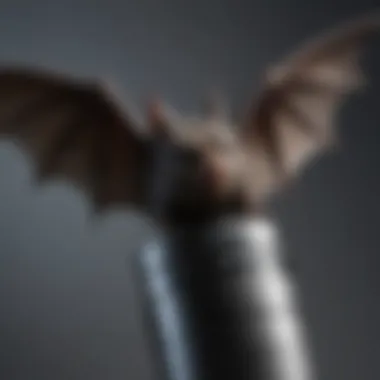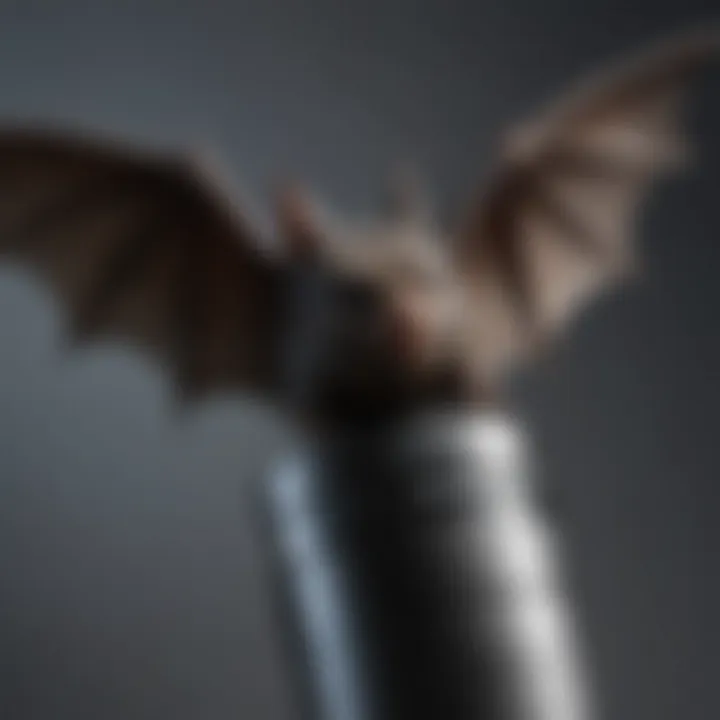Ultrasonic Bat Repellent: Effectiveness and Insights


Intro
Ultrasonic bat repellent devices occupy a unique niche in the realm of pest control. As bats become increasingly recognized for their ecological importance, the need for effective and humane methods of managing their presence around homes and gardens has surged. Ultrasonic devices claim to deter bats using high-frequency sounds that are inaudible to humans but harmful to these flying mammals. Understanding the mechanisms behind these devices is essential for evaluating their claims and effectiveness.
In this article, readers will gauge the reliability of various ultrasonic bat repellent products. This includes an analysis of user feedback to establish a clear picture of performance. Furthermore, the ecological implications of deploying such technologies will be brought to the forefront. By carefully weighing effectiveness against potential environmental concerns, homeowners can make informed choices that prioritize both pest management and ecological balance.
Understanding Pests
Definition of Pests
Pests can generally be defined as any organisms that significantly interfere with human activities, particularly in domestic settings. This category encompasses insects, rodents, and also includes bats. Bats, despite their often-negative perception, play crucial roles in our ecosystems, mainly through pest control and pollination. Nonetheless, their presence within residential areas can lead to discomfort and potential health risks.
Importance of Pest Identification
Identifying pests is a fundamental step in effective pest management. Understanding whether the issue pertains to bats, insects, or other wildlife allows homeowners to select the most appropriate methods of control. For instance, bats are beneficial yet can create complications when they roost in attics or near living spaces. Recognizing their presence as a pest requires tailored solutions that respect both the homeowner’s needs and ecological considerations. Effective pest identification leads to more targeted approaches, enhancing overall success in managing unwanted organisms.
Prevention Techniques
Home and Garden Preventative Measures
Implementing preventive strategies can significantly reduce bat incursions. Here are some effective measures:
- Seal Entrances: Inspect buildings for gaps or holes that may allow bats entry. Seal these with caulk, screens, or other materials.
- Limit Attractiveness: Ensure that outdoor lighting does not attract insects, which in turn attract bats. Consider using motion-activated lights.
- Trim Vegetation: Maintain trees and shrubs to reduce the inviting nature of your property.
Seasonal Prevention Tips
Seasonal changes can affect bat behavior. During warmer months, bats may seek shelter in garages or attics. Thus, in spring, homeowners should conduct thorough inspections. In contrast, fall may require enhanced alertness as bats prepare to roost for the winter. Engaging in regular upkeep of one’s home can thwart many potential access points.
Eco-Friendly Pest Control Solutions
Overview of Sustainable Practices
Sustainability reigns supreme in modern pest control strategies. Eco-friendly solutions ensure that while pests are deterred, the surrounding environment remains intact. Ultrasonic repellents fall into this category as they minimize chemical usage, which can have harmful consequences for non-target species.
Natural Remedies and Their Effectiveness
Natural remedies present another avenue for eco-conscious homeowners. Many opt for solutions such as:
- Essential Oils: Certain oils like peppermint and eucalyptus can repel bats.
- Physical Barriers: Bird netting can effectively block entry points without causing harm to bats.
Such measures can complement ultrasonic devices, creating a multi-pronged approach to pest management.
"Sustainable pest management considers both the needs of the homeowner and the well-being of wildlife."
By embracing eco-friendly practices, homeowners are better equipped to create resilient homes, deterring bats while fostering a harmonious relationship with nature.
Prologue to Ultrasonic Bat Repellents
The presence of bats within residential areas can pose various challenges. While they play an essential role in ecosystems, especially in controlling insect populations, their habitation in or near homes may lead to irritations for homeowners. This is where ultrasonic bat repellents come to play. These devices offer a non-invasive solution to deter bats from nesting in unwanted areas. Understanding this topic is crucial for anyone looking to manage bat populations effectively around their property.
Using ultrasonic devices can bring a range of benefits, from reducing the risk of property damage to minimizing health hazards associated with bat droppings. Homeowners who seek these solutions need to consider not only the functionality of each device but also the broader ecological impacts they may impose. By analyzing the mechanisms and effectiveness of these repellents, we aim to create a comprehensive guide for consumers.
Understanding the Need for Bat Repellent
Bats become a concern when they choose to settle in spaces some consider personal territory. These areas can include attics, garages, and porches. The need for bat repellent stems from the desire to maintain a comfortable living environment. Besides the nuisance that comes from their noises, their presence can lead to potential structural damage as they roost.
Homeowners often worry about the health risks associated with bats. Bats can harbor diseases, such as histoplasmosis, which is linked to their droppings. Therefore, it becomes pertinent to find effective ways to encourage bats to seek homes elsewhere. Ultrasonic bat repellents present an interesting option for those avoiding harmful chemicals or inhumane traps.
How Ultrasonic Devices Work
Ultrasonic bat repellents emit high-frequency sound waves, typically above the range of human hearing. These sound waves are designed to disrupt the echolocation bats use to navigate and forage. By creating a disorienting environment, the devices aim to make the area less appealing to bats.
Most devices operate in a cyclical pattern, changing frequencies to avoid bats becoming accustomed to a single sound. This dynamic frequency shifting can potentially increase the device's effectiveness, as bats might be less inclined to adapt to the sound stimulus. The range of the devices can vary, though many claim to cover significant distances, depending on environmental factors that might dampen sound propagation.


Utilizing these devices is relatively straightforward. Once set up, homeowners can rely on them to work without daily maintenance. However, it is important to monitor their effectiveness periodically to ensure sustained bat deterrence.
Ultimately, the successful use of ultrasonic bat repellents will depend on the specific environment and bat behavior.
Understanding these underlying principles regarding how ultrasonic devices function empowers homeowners to make informed decisions based on their unique situations.
Types of Ultrasonic Bat Repellents
Understanding the different types of ultrasonic bat repellents is essential when deciding how to manage unwanted bat populations. The various designs cater to diverse settings and user preferences. Each type has unique benefits and considerations that can affect their overall effectiveness. Given the potential challenges bat infestations pose to homes and health, selecting the right repellent plays a critical role in ensuring a safe environment.
Passive Devices
Passive ultrasonic bat repellents operate without the need for batteries or external power sources. These devices usually emit sound waves that can interfere with bats' echolocation abilities. The aim is to create an uncomfortable environment for bats, causing them to seek out alternative locations.
One notable advantage of passive devices is their low maintenance requirements. Homeowners do not need to worry about changing batteries or recharging the unit. They are also generally more economical than other options. However, their effectiveness may vary depending on environmental factors and the specific frequency of sound produced.
Battery-Operated Options
Battery-operated ultrasonic bat repellents offer flexibility in placement and operation. As they can be moved easily, homeowners can strategically position them for maximum effectiveness. These devices often generate a range of frequencies aimed at disrupting bats' natural navigation and communication.
The key considerations associated with battery-operated devices are power supply and durability. Regularly replacing batteries may be inconvenient for some users, especially in high-demand settings. Additionally, the lifespan of the device may vary based on the quality of components used in manufacturing. Users should look for models that provide longer battery life while maintaining strong performance.
Solar-Powered Alternatives
Solar-powered ultrasonic bat repellents represent a sustainable choice for environmentally conscious homeowners. These devices harness solar energy to operate, making them cost-effective in the long run. This not only eliminates ongoing battery costs but also reduces environmental impact.
Solar-powered systems typically require direct sunlight to function effectively. Hence, placement is critical. They may not perform well in shaded areas. However, their continuous operation without reliance on fluctuating energy sources is a major advantage. Homeowners who prefer eco-friendly solutions will find these devices appealing.
Criteria for Evaluation
In the realm of ultrasonic bat repellents, evaluating the effectiveness of each product becomes essential. This section dissects critical criteria that consumers should assess before making a purchase. These criteria are not merely suggestions; they play a significant role in determining whether a device will fulfill its intended purpose of repelling bats effectively. Each criterion listed here helps users gauge the suitability of a repellent for their unique needs, providing clarity in a marketplace that can be overwhelming.
Effectiveness and Range
Effectiveness stands out as a primary concern when reviewing ultrasonic bat repellents. Not all devices function equally well, as various factors influence their performance. The frequency of the ultrasonic waves and coverage area are paramount considerations. Devices typically emit sounds that target bats' hearing range, which is generally between 20 kHz and 65 kHz. A product's range indicates how far these waves can travel, which impacts its capability to cover larger spaces, such as attics or barns.
For instance, a device with a range of 2,000 square feet may suffice for a small garage, while larger properties may require units with extended range capabilities. User feedback often highlights the effectiveness of specific models, allowing potential buyers to understand better how these repellents perform in real-world scenarios.
Ease of Use
Ease of use cannot be overlooked. Ultrasonic bat repellents should offer convenience from installation to operation. Some devices require professional installation, which may not appeal to all homeowners. In contrast, many models boast a plug-and-play design, allowing for straightforward setup. Consumers often appreciate when products come with clear instructions and no complicated configurations. Furthermore, ease of use includes the ability to adjust settings or switch the device on and off with minimal hassle.
By examining user reviews, it becomes evident which products truly fit the "easy to use" label. Products that offer straightforward controls and simple maintenance tend to receive better ratings. Homeowners should prioritize devices that require minimal effort to operate, enhancing their overall experience and effectiveness.
Durability and Cost
Durability is an equally vital aspect that consumers should consider. Repellent devices are often exposed to various environmental conditions, especially those designed for outdoor use. A durable product can withstand elements like rain, temperature variations, and sunlight without degrading in performance. Many reputable brands provide product specifications, highlighting their materials and build quality.
Cost, however, plays a critical role in decision-making as well. While higher-priced models may boast more features or promising performance, it is essential to assess whether those features correlate to real benefits. Reviews often reveal the long-term value of these products. Therefore, consumers must evaluate their budget against durability and effectiveness, ensuring a well-rounded purchasing decision.
"Investing in a quality ultrasonic bat repellent can save you from hundreds of dollars in potential damage caused by bats."
These criteria collectively create a framework for evaluating ultrasonic bat repellents. A thorough analysis based on these points will empower consumers to make informed decisions aligned with their situations.
Review of Top Ultrasonic Bat Repellents
The review of top ultrasonic bat repellents serves as a vital part of this article. It provides readers with direct insights into the best products currently on the market. Bat control is often challenging for homeowners, making it critical to choose an effective solution. By discussing specific products, we provide concrete examples, showcasing what works and what does not. This section helps demystify the options available, giving readers a clear understanding of their choices.
Product A: Overview and User Feedback
Product A, named the Havahart HT0610, is known for its user-friendliness and effectiveness. Many users report that it successfully reduces bat activity in their vicinity. This device emits high-frequency sound waves designed to deter bats without harming them. Users have shared their positive experiences through online platforms. Feedback highlights ease of installation and noticeable reduction in bats within a few weeks of usage.
"The Havahart HT0610 had a huge impact on my home. I noticed fewer bats flying around after just a couple of weeks!"
— Satisfied user


However, some customers encounter challenges, particularly in larger outdoor spaces. The device's range can be limited under certain conditions, leading to mixed experiences in effectiveness.
Product B: Performance Analysis
The T3 Raccoon Repellent has drawn attention for its marketing as a multi-purpose pest control device. While primarily aimed at raccoons, it features ultrasonic technology effective against bats. Users seem satisfied with its functionality. Reviewers note a significant decline in bat sightings after installation. However, there are limitations regarding its range and durability in different environments.
Users mention that the T3 Raccoon Repellent works best in enclosed areas or smaller yards. Performance may diminish in larger, open spaces due to the weak sound wave propagation. It's essential to assess the surrounding environment before choosing this product.
Product C: Comparative Insights
In comparing Havahart HT0610 and T3 Raccoon Repellent, one can see distinct advantages and disadvantages. While both devices utilize ultrasonic technology, their effectiveness varies based on user feedback and specific scenarios.
- Effectiveness
- Ease of Use
- User Satisfaction
- Havahart HT0610 is favored for its efficiency in reducing bat populations.
- T3 Raccoon Repellent offers value as a multi-use solution but is less effective in expansive yards.
- Both devices are uncomplicated to set up, but the Havahart device may require more placement consideration for optimal results.
- Havahart HT0610 receives consistently positive feedback.
- T3 Raccoon Repellent has a mixed reception, with users appreciating its versatility but noting limitations in specific conditions.
These comparisons shed light on the importance of considering individual circumstances when selecting an ultrasonic bat repellent device. Understanding the nuances of each product can lead to better decisions for effective bat control.
User Experiences and Testimonials
User experiences and testimonials play a crucial role in evaluating ultrasonic bat repellents. These firsthand accounts from actual users provide insights that go beyond technical specifications. They reveal how these devices perform in real-world scenarios. Understanding user feedback is essential for prospective buyers who seek efficient solutions for unwanted bat intrusions.
Many consumers rely on personal stories to gauge the effectiveness of a product. This is especially true for homeowners facing bat problems, which can cause significant distress. Participating in conversations about these devices helps bring clarity to their utility. Positive outcomes, as well as challenges faced during usage, are valuable data points that help potential buyers make informed choices.
Positive Outcomes
In several cases, users have reported notable success with ultrasonic bat repellents. Many found these devices largely effective in keeping bats at bay. When placed strategically, these devices emitted high-frequency sounds that deterred bats without causing them harm.
Some common positive feedback includes:
- Immediate Results: Users often noticed a quick reduction in bat sightings after installation.
- User-Friendly: Many devices are easy to set up and operate, requiring minimal effort from homeowners.
- Humane Solution: For those concerned about animal welfare, these repellents provide a non-lethal method for bat control.
- Cost-Effective: Many users praised the long-lasting nature of ultrasonic devices, highlighting their value over time.
"After just a few days of using my ultrasonic repellent, I noticed a significant drop in bat activity around my home," mentioned one satisfied user.
Challenges Faced
Despite the success stories, it's important to address the challenges some users experienced. Not all ultrasonic bat repellents yield satisfactory results for every user or location. Some reported that bats became accustomed to the sounds over time, diminishing the repellent's effectiveness.
Notable challenges include:
- Variable Effectiveness: Not every household reported similar results, suggesting that landscape and bat behavior may impact performance.
- Coverage Limitations: Users found that some devices did not cover large areas effectively.
- Initial Investment: Although some devices are cost-effective in the long run, the initial purchase can be a barrier for some homeowners.
- Noise Sensitivity: A few users noticed that the sounds emitted could also disturb other pets or wildlife nearby, which raised concerns for some households.
Evaluating user experiences provides essential perspective on the practicalities of using ultrasonic bat repellents. As potential buyers consider these devices, understanding both the benefits and challenges is vital in making an informed decision.
Ecological Considerations
Understanding the ecological impact of ultrasonic bat repellents is essential for both consumers and wildlife advocates. This section explores significant aspects around how these devices may influence bat populations and the broader environment. As homeowners consider methods for bat control, it becomes crucial to evaluate the implications these devices may have on the ecosystem.
Impact on Bat Populations
The use of ultrasonic bat repellents raises concerns about their effect on bat populations. Bats are vital to ecosystems for various reasons, including pollination and pest control.
Notably, the sound frequencies emitted by these devices may disrupt bat behaviors. Some studies suggest that high-frequency sounds can lead to disorientation, causing bats to avoid certain areas. This avoidance could potentially disturb their hunting and roosting habits. Therefore, it's important to consider that excessive use of ultrasonic repellents may lead to population declines in certain areas.
Moreover, bats are already facing threats from habitat loss and disease. Thus, utilizing repellents without understanding their ecological implications might exacerbate their already vulnerable status. Homeowners need to be responsible users of these devices, ensuring that any pest management practices do not adversely affect local bat populations.
Sustainable Pest Management Practices
Incorporating sustainable practices into pest management is always advisable. Homeowners can take several steps to ensure a balance between repelling bats and preserving their populations.


- Integrated Pest Management (IPM): This approach combines multiple strategies, such as modifying the environment to make it less inviting for bats.
- Non-lethal Methods: Employing solutions like bat houses can provide alternative roosts away from human dwellings. This way, bats can be redirected to suitable habitats instead of simply deterred.
- Chemical Options: If ultrasonic devices are deemed ineffective, chemical repellents can be considered as a last resort, always preferring those that are environmentally friendly.
- Regular Inspection: Periodic examination of potential nesting sites can help in proactively managing bat populations before they become a problem.
Alternatives to Ultrasonic Repellents
In the pursuit of bat control, ultrasonic repellents serve as a popular option. However, to ensure a well-rounded approach, it is crucial to explore alternatives that may complement or serve as substitutes to ultrasonic technology. This section discusses two primary categories of alternatives: chemical repellents and physical barriers. Evaluating these options highlights their specific elements, benefits, and considerations, allowing homeowners to make informed choices in managing bat populations.
Chemical Repellents
Chemical repellents are substances designed to deter bats using specific odors or tastes. These products leverage various active ingredients to create an environment that is unwelcoming to bats. Often, they are easy to apply and can be found in liquid or aerosol forms, making them accessible for most consumers.
One popular chemical repellent is naphthalene, which emits a strong odor that is usually disliked by many wildlife species. Another common option is essential oils like peppermint or citronella, which are often touted for their efficacy in repelling bats due to their potent scents. While chemical repellents can be effective, they also raise some important considerations:
- Application Frequency: Most chemical repellents require regular reapplication, especially after rain or heavy wind.
- Safety Concerns: It is crucial to ensure the chosen product does not harm non-target species, such as pets or beneficial insects. Read labels carefully and follow the recommended safety practices.
- Environmental Impact: Some chemical options may have adverse effects on soil and water quality, thus weighing these impacts is essential before application.
Including chemical repellents in your bat control arsenal can offer immediate results, but it is wise to consider their implications in a broader ecological context.
Physical Barriers
Physical barriers present another viable solution for bat control. This approach involves creating obstructive measures to prevent bats from roosting or accessing specific areas. The installation of barriers can be a more permanent solution compared to repellents.
Common types of physical barriers include:
- Netting: Fine mesh netting can effectively block entry points while allowing ventilation. It is critical to securely fasten the netting to avoid unintended openings.
- Foam Sealants: Expanding foam sealants can fill gaps in structures, eliminating potential bat entry points, particularly in attics or under eaves.
- One-Way Exclusion Devices: These devices allow bats to exit but prevent them from returning. Such an approach can be useful if you have an established population.
Considering physical barriers comes with benefits:
- Durability: Once installed, physical barriers require minimal maintenance.
- Non-Toxic: Unlike chemical repellents, these methods do not pose risks of toxic exposure to pets or humans.
- Effectiveness: In many cases, a combination of exclusion devices and netting can provide the strongest defense against unwanted bat habitation.
"Using both chemical and physical solutions may provide a more integrated approach, allowing for flexible responses to bat control challenges."
Homeowners should assess their unique situations to determine the best approach. Alternatives like chemical repellents and physical barriers may provide practical solutions to complement or replace ultrasonic options in bat management strategies.
Addressing Common Concerns
The topic of addressing common concerns in the use of ultrasonic bat repellents is vital for consumers who seek effective solutions for controlling bat populations. These concerns arise primarily from the potential impact on non-target species, the long-term effectiveness of the devices, and the overall ecological implications. By understanding these aspects, homeowners can make informed choices that ensure a balance between pest control and environmental preservation.
Safety for Non-Target Species
One primary worry is the safety of non-target species when using ultrasonic bat repellents. Many homeowners are concerned about how these devices might affect other wildlife in their vicinity. Ultrasonic devices operate by emitting high-frequency sounds that are mostly inaudible to humans but can be distressing to bats and other animals. This leads to the question: Do these sounds harm non-target species?
Research indicates that the frequencies used in these devices can affect various animals, but the impact is generally low. Birds, for instance, are often less affected by these sounds, while rodents may experience some levels of discomfort. Nevertheless, many manufacturers aim to minimize risks by ensuring that their devices focus on frequencies that deter bats without significantly disrupting the surrounding wildlife. It is crucial to review product specifications and user feedback on the safety of these devices.
Effectiveness Over Time
Another essential point of concern is the effectiveness of ultrasonic bat repellents over time. Homeowners may wonder if the devices remain effective after prolonged use. Initial studies suggest that while they can significantly reduce bat presence, the lasting power of their effectiveness varies based on several factors.
- Frequency Variation: Some ultrasonic repellents may provide a consistent frequency output, which can become less effective over time if bats habituate to the sound.
- Environmental Conditions: Factors like weather, structural changes, and the natural presence of other sounds can affect how well the device works in a specific location.
- Device Maintenance: Regular maintenance, like cleaning the device and checking battery life, is essential for maintaining functionality.
Homeowners have reported mixed experiences with long-term effectiveness, which underscores the need for ongoing evaluation of the device's performance.
The End and Recommendations
In the realm of pest control, ultrasonic bat repellents present a unique solution for homeowners seeking to mitigate unwanted bat intrusions. The final section synthesizes core insights about these devices while providing actionable recommendations for effectively utilizing them. Understanding how these technologies function and what they can achieve is paramount in making informed choices that respect both human comfort and ecological balance.
Summary of Findings
Through the evaluation of various ultrasonic bat repellents, certain patterns and conclusions emerge:
- Effectiveness Varies: The degree of success with different products relies heavily on specific characteristics such as frequency output and placement within the environment.
- User Feedback is Mixed: Many users report varying experiences, with some finding notable reductions in bat sightings while others express skepticism about efficacy. User reviews highlight the need to have realistic expectations.
- Consideration for Non-Target Animals: While designed for bats, ultrasonic devices can potentially influence other wildlife. It is crucial to select products with a safe range for surrounding fauna.
- Eco-Friendly Options: Many ultrasonic models contribute to sustainable pest control methods, aligning with modern ecological practices.
Ultimately, consider product specifications and personal environment when selecting the best solution.
Guidance for Consumers
Choosing the right ultrasonic bat repellent involves careful consideration of various factors. Here are some recommendations to guide consumers:
- Assess Your Needs: Determine if you experience frequent bat issues and where these occur most often. Identify the specific challenges you face, which will help narrow down suitable products.
- Evaluate Product Features: Look for devices that offer adjustable frequency settings. This feature can be significant since bats may adapt to consistent sounds.
- Read Reviews Thoroughly: Pay close attention to user testimonials. Look for patterns in feedback regarding effectiveness and ease of use. Consider platforms like Reddit for diverse opinions.
- Safety First: Investigate whether the device is safe for pets and other wildlife. Browse through manufacturer guidelines and consult consumer safety resources.
- Budget Considerations: Prices can vary significantly among different products. Balance quality and cost. Sometimes, investing a bit more can lead to better long-term results.
- Stay Informed: Follow links to educational materials on platforms like Britannica and Wikipedia to understand better the complexities of bat behaviors and effective repellents.
The effectiveness of ultrasonic bat repellents is influenced by multiple factors, including frequency, user placement, and specific bat behavior.
By considering these guidelines, consumers can make educated decisions, enhancing their home environment while also acting responsibly toward local wildlife.



